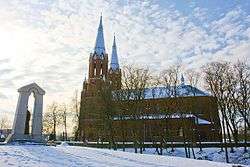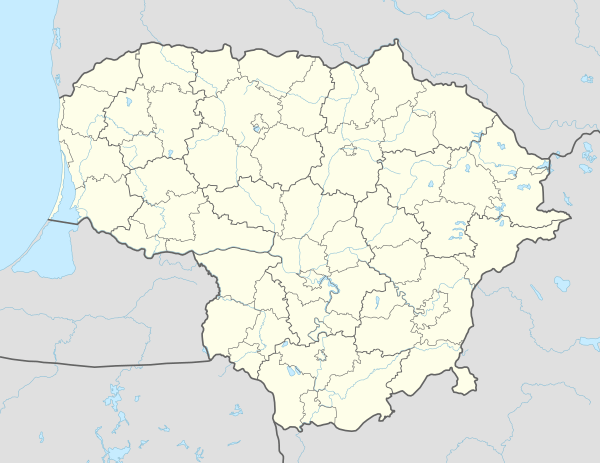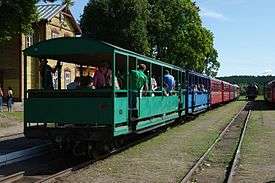Anykščiai
Anykščiai (![]()
Anykščiai | |
|---|---|
City | |
 Anykščiai Church – the tallest church in Lithuania | |
 Coat of arms | |
 Anykščiai Location of Anykščiai | |
| Coordinates: 55°32′N 25°6′E | |
| Country | |
| Ethnographic region | Aukštaitija |
| County | |
| Municipality | Anykščiai district municipality |
| Eldership | Anykščiai eldership |
| Capital of | Anykščiai district municipality Anykščiai eldership |
| First mentioned | 1440 |
| Granted city rights | 1516 |
| Population (2011) | |
| • Total | 10,575 |
| Time zone | UTC+2 (EET) |
| • Summer (DST) | UTC+3 (EEST) |
The city has a football club, FK Anykščiai.
Name
Anykščiai is the Lithuanian name of the town. Its name in other languages includes Polish: Onikszty; Russian: Они́кшты, romanized: Onikshty; Belarusian: Ані́кшты, romanized: Anikshty; Yiddish: אַניקשט, romanized: Aniksht; German: Onikschten.
History

Archeological research in the area has revealed settlements dating from the late Neolithic. Anykščiai were first mentioned in 1440 as a possession of Grand Duke of Lithuania Kazimieras Jogailaitis which was attributed to manage to Radvila Astikas.
Its location on the Šventoji River, connecting it to the Baltic Sea via the Neris River and Neman River, contributed to its development. It also lay on a land route between the cities of Vilnius and Riga. Its strategic importance led to frequent assaults by the Teutonic Order. The first written mention of the town dates to 1442; its first appearance on a map is dated tentatively to about 1578.[2]
Anykščiai is a place were many Lithuanian poets and writers originated from - Antanas Vienuolis, Antanas Baranauskas, Jonas Biliūnas. It is called Weimar of Lithuania for that reason. There are about 250 culturally and historically important places in Anykščiai and Anykščiai district - Anykščių šilelis, to which the poem The Forest of Anykščiai of A.Baranauskas was dedicated for, Puntukas boulder, monument Beacon of Happiness, canopy walkway, horse museum, manors and old Lithuanian fort hills shrouded in mystery and legends.
Prior to Lithuania re-establishing its independence after World War I, Anykščiai was part of the Kovno Governorate of the Russian Empire. A shtetl existed within the town, with a Jewish population of 2,754 in 1900.[3]
Wool processing facilities, a winery, and Lithuanian and Jewish schools were established after World War I, when its population reached about 4,000. During World War II, its bridges and city center were destroyed. In summer 1941, two mass executions of the local Jewish population occurred.[2] Around 1,500 Jews were murdered by German Nazis and their local collaborants.[4]
After the Soviet occupation, Anykščiai became a center of Aukštaitija partisans. Anykščiai district was the only one in Lithuania which belonged to 5 partisan military districts (apygarda) - Algimantas, Didžiosios Kovos (The Great Fight), Vytis, Vytautas and to a third district of Northern Lithuania - Aukštaitija by the Lithuanian Freedom Army. In 2014 in Šimonių giria (The Šimoniai Forest) a cognitive route was created which leads through the places of the Algimantas military district partisan paths and places.[5]
Industry
Famous in Lithuania fruit winery Anykščių vynas, established in 1926 by Balys Karazija.
Notable natives and residents
- Józef Abelewicz, Polish theologian
- Antanas Baranauskas, poet, whose home is preserved in Anykščiai Regional Park.
- Jonas Biliūnas, writer
- Giedrius Titenis, swimmer
- Antanas Vienuolis, writer
- Bronė Buivydaitė, writer
- Greta Baldauskaitė, psychologist
Twin towns — sister cities
Anykščiai is twinned with:[6]
References
- (in English) Skiing in Lithuania - Ski vacation in Lithuania
- "History". Anykščiai district municipality. Archived from the original on 2011-04-11. Retrieved 2009-12-16.
- JewishGen
- "Holocaust Atlas of Lithuania". www.holocaustatlas.lt. Retrieved 2019-01-24.
- Anykščiai laukia besidominčių partizanų kovomis: čia įrengtas naujas pažintinis maršrutas
- "Anykščių miesto partneriai". anyksciai.lt (in Lithuanian). Anykščiai. Retrieved 2019-09-01.
